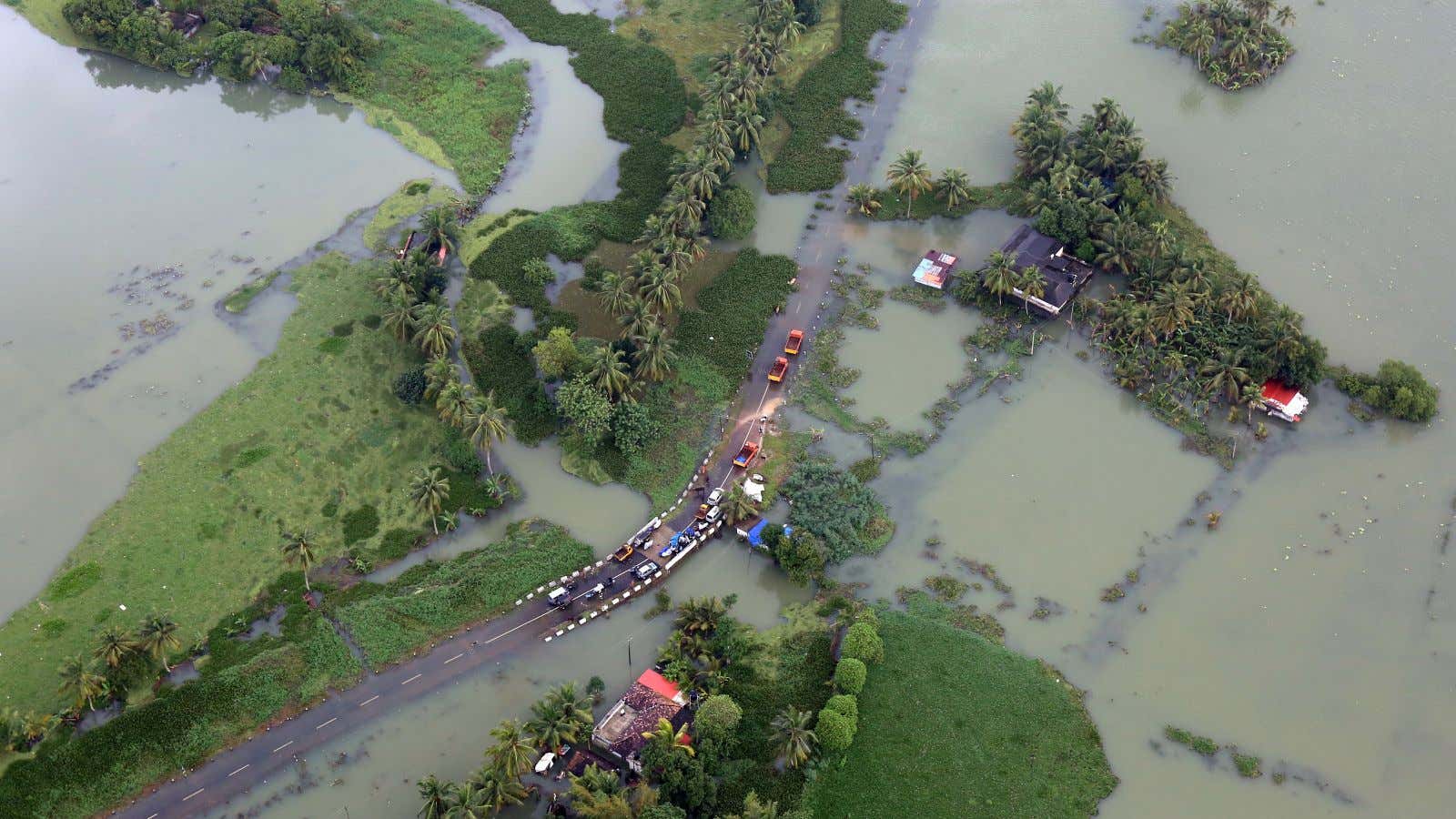The past fortnight’s catastrophic floods may wipe out nearly a percentage point from Kerala’s economic growth.
The southern Indian state’s GDP growth is expected to fall to 6.5-7% from the budgeted 7.6% for the financial year 2019, said an Aug. 21 report by rating agency Care Ratings.
“Agricultural output would definitely be affected and growth can be negative,” according to the report.
Around 400 people have died and more than a million were displaced in the state after unexpected and heavier-than-usual rain left all of its 14 districts badly flooded. The worst calamity in nearly 100 years has inflicted damages of up to Rs21,000 crore ($3 billion) on Kerala. Apart from about 100,000 buildings destroyed, including residential ones, some 10,000 kilometres of highways have been wrecked and millions of hectares of crops washed away.
Accounting for 2.8% of India’s population but contributing nearly 4% to the country’s economy, Kerala is now slowly limping back to normalcy.
While the predominantly consumer state is not known as an industrial hub, it is home to several companies in the IT, auto, shipping, banking, and insurance sectors that are now counting their losses.
Here’s a look at how businesses will suffer.
The losses
Being a consumption-driven economy, discretionary spends are going to be most affected in the coming months.
Automobile: Kerala’s annual festival period of Onam falls between Aug. 24 and Sept. 04, a time when sales of consumer durable products and automobiles pick up. But not this year. Sales of such non-essential items will remain tepid, believes capital markets and investment group CLSA.
The auto industry estimates that inventory worth Rs1,000 crore has been damaged.
Costs are likely to be recovered partially or fully given that they are insured, but the process may be time-consuming. Typically, insured losses are about 5-6% of the economic losses. In Kerala, the insurance claims are expected to be in the range of Rs1,000 crore-1,200 crore, Roopam Asthana, CEO at Liberty Videocon General Insurance, told Quartz. On the flip side, these payouts will also affect the earnings of insurance companies.
Meanwhile, as auto majors grapple with the loss, they will also have to tackle low sales. “Apart from the immediate impact where sales will be wiped out for two months, it will take at least another four months before things start inching back to normal. Therefore, auto companies, including Maruti Suzuki and Hyundai that are both very strong in the market will be hit,” said Deepesh Rathore, director at auto consulting firm Emerging Markets Automotive Advisors.
Rubber: Kerala accounts for about 85% of India’s rubber production. With the supply chain now severely affected, tyre companies such as JK Tyres, Apollo Tyres, CEAT, MRF, etc. are likely to be hit. A lot of these companies also have production hubs in the state which were shut due to floods. It may take a week more for normalcy to return.
IT: Kerala is home to 10 IT parks, which employ around 200,000 people (pdf). Several large Indian IT companies, including Tata Consultancy Services and Infosys, have their offices in the state. “While companies may try to shift their work to other offices, projects are likely to get delayed in the short-term,” explained Harish HV, an independent IT consultant. “As a result of the disruption, the firms will also have to convince customers to not pull out and all of this will have an impact on their earnings in the short-term.”
There is still hope…
Tourism accounts for 10% of the state’s gross domestic product (GDP), generating around Rs30,000 crore and employing around 1.4 million people. The industry is in tatters today. Analysts expect it to be one of the worst-affected businesses in Kerala especially as August-October is favoured by domestic travelers.
Yet, tourist guides that Quartz spoke to are optimistic.
“The peak season starts from October second week and a lot of international tourists also come after that. I think by that time Kerala would have had recovered and we will be able to manage,” said PX Eugine Gevarghese, a tourist guide from Kerala.
The state is also home to over 2,000 startups. Even though there have been temporary disruptions, considering that a lot of these companies have clientele outside India most of them will not be affected, believes Saji Gopinath, CEO of Kerala Startup mission, a state-run incubation and entrepreneurship development outfit. “Some of them that are in the travel or real estate sector will see some impact but most of the startups are into products that are supplied in different geographies, so they will be shielded,” he added.
Four commercial banks and one small finance bank are based in Kerala, and on average more than 25% of their total loan book is centered on the state. They may see an uptick in bad loans but the situation is not dire. Last week, a State Level Bankers’ Committee, a consortium of public and private sector banks, provided a breather to debtors by relaxing loan repayment schedules between a month and a year depending on the category.
“This will enable customers to defer payments and meet their obligations later. It is good for the banks as well as these loans typically should not turn into non-performing assets due to the extension offered,” explained Ashutosh Khajuria, executive director of Federal Bank, a private sector lender headquartered in Kerala.
Meanwhile, over the years, the state’s farmers have moved from short-terms crops like paddy to rubber and coffee plantations. This has ensured that effect of the floods on agriculture, though severe, is still less than what could have been.
“The loss is big for people and there is no doubt about it, but at the industrial and agri-level things are not going to be that bad and they should be able to re-build the state much sooner,” said G Chokkalingam, managing director of Equinomics Research and Advisory.
